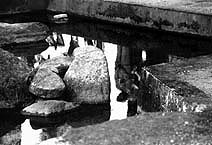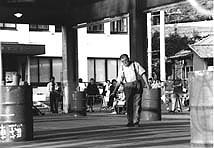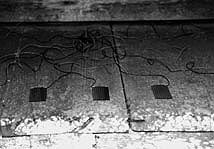"The Third Festivity on an Ancient Hill --For Sacred Sites"
A Report on a Japanese Sound Art Festival by K.K. (journalist)
You've probably heard about international sound art festivals,
but how about one in Japan? The "Festivity on an Ancient Hill"
is a wonderful festival held in Kyoto's Tango Region that this year played
host to the world's leading sound artists, providing visitors with a variety
of interesting events and opportunities for discovery. The festival, given
for the third time this year, is produced by the sound artist SUZUKI Akio,
known to many readers through the lengthy interviews that appeared in SA
last year. For those who were unable to attend, K.K., a young newspaper
reporter, brings news of the unique sights and sounds he experienced.
The Third Festivity on an Ancient Hill
Over a few breezy, clear days in May, a sound art festival called "Festivity
on an Ancient Hill" was held in Tango, the northern part of Kyoto Prefecture.
Artists at the forefront of their field internationally came to this distant
area dotted with burial mounds from the ancient past to enjoy themselves,
give performances, and create installations. In the modern age, people have
lost the ability to hear the sounds of nature. But by coming into contact
with sound art, it is hoped that listeners will be able to regain the ears
of a baby and return to a mental state that is open and pure. This, at least,
is the goal of the producer.
The production of this three-day event is handled by one of the pioneers
of Japanese sound art, Suzuki Akio. In 1987, Suzuki moved from Tokyo to
Kyoto's Amino-cho, and in 1989, took up residence in the neighboring town,
Tango-cho. The festival started as a kind of private "play," but
the third edition this year, was expanded to include spaces in Amino-cho
and Kumihama-cho. Support from people of the town and surrounding areas
has increased, and this year a bus tour taking visitors to the exhibition
and performance spaces was organized. The tour made it convenient for people
to bridge the distance between the spaces, and focused especially on the
work of foreign sound artists.
After a nearly three-hour trip on an express train from Kyoto Station,
I arrived at Kumihama Station, where I was met by NAKAGAWA Shin, the leader
of the Darma Budaya gamelan ensemble. His group performs primarily with
bronze percussion instruments from Indonesia that have became quite well-known
for their ability to stimulate the brain in positive ways such as increasing
alpha waves. In the square surrounding the front of the station, about 100
people came to hear the group's performance. Along with the pleasant sensations
created by the gentle, metallic reverberations, the music created a relaxing
atmosphere.
Of the artists who came to "play," four were from foreign countries:
from Germany there were Rolf JULIUS and Hans Peter KUHN, and from Holland
Paul PANHUYSEN and Felix HESS, all of whom had worked with Suzuki in the
past.
The theme of this year's event was "For Sacred Sights." This
meant that each of the four artists chose their own installation or performance
site--either a truly sacred space such as a shrine or temple, or a sight
they considered sacred such as a work place used by local people; in one
case, the fishing port.
Lotus 2
|

|
|
Julius: Lotus 2 |
|
After boarding the bus, the first place I visited was Sounji Temple
in Kumihama-cho. Julius's sound installation, "Lotus 2," had been
set up here. Based on the idea of having "a few sounds blossom in the
pond in front of the temple gate," there were loudspeakers installed
at two places in the pond and one on the temple's mountain gate. Cassette
tapes played metallic sounds with other bird-like chirps mixed in. |
|
Visitors could take a seat around the pond and listen as long as
they liked. There was a line of 400-500-year-old cedar trees, patches of
sunshine slipping through them, fresh air to breath, and a gentle breeze.
It was all very calm and peaceful. After a time, the clear timbre of a flute
could be heard. When I walked in the direction of the sound, I found Suzuki
playing an iwabue (stone flute) beneath the bell in the bell tower.
"I made all the sounds I used here myself. There are sounds from
a buzzer and computer sounds all mixed together in complicated ways,"
explained Julius, "There are some sounds that could only be possible
in this place. The grounds of this temple have a relaxed atmosphere and
the passage of time is slow. It would be boring to use the same type of
peaceful sounds, so I chose the opposite--sounds that convulse." At
first, it seemed difficult for the listeners to relax. But Julius reacted
by saying, "Listeners are another part of the work--a living part.
This is a great experience for me." The sounds of a baby crying or
trains passing in the distance became elements that increased the silence
of the surroundings. A truly wondrous space had been created. |
Sounds for a 'Space in the Sun'
The next place I visited was "Space in the Sun," an area built
on the side of Mount Takaten in Amino-cho. This is the most northerly land
area on the meridian of 135 degrees east longitude and 35 degrees north
latitude. In 1988, Suzuki built two 3.3-meter-high, 17-meter-long walls
here out of handmade bricks. On one fall day, he used the seven-meter space
between them to give a performance that consisted of listening to the natural
sounds around him.
The installation in this space was created by Hans Peter Kuhn. On one
wall, there were eight loud speakers hanging from wires that played sounds
from four CD players set up on the other side of the wall. On the opposite
wall, eight Polaroids were attached to correspond to the speakers across
from them.
"'Space in the Sun' is architecturally very sturdy. That's why I
decided to take a simple approach and use a bunch of similar, small objects.
To me, sound and color are deeply related. I chose objects with different
colors, and made photographs to correspond to the color of the sounds. The
eight photographs are eight small windows in the wall from which you can
see eight different views of space," explained Kuhn. It was amazing
to see this "perfectly realized" artificial space, through the
power of Kuhn's work, completely melt into its natural surroundings.
|
Paul Panhuysen chose the fishing port in Tango-cho's Taiza section to present
his installation/performance "Two Fans." Inside the market, seven
steel wires from 8-30 meters in length were arranged to resemble the shape
of two fans opposite each other when viewed from above. By slowly rubbing
the wire with the palms of his pine-rosined hands, sound was emitted from
oil drums that had been used to support the wires and had now become resonators.
The sound was a grating, monotonous moan, but there was definitely something
striking about it. |
Two Fans and The Transformation of Light into Sound
 |
|
Paul Panhuysen |
|
|
Panhuysen said, "I perform improvisations
to fit the environment I find myself in at the time. I don't worry about
whether or not it's music. As an artist, the most important thing to me
is that there is always a chance for some kind of new discovery to happen
for me and for the listeners." Panhuysen used the flame of a lighter
to cut the wires and finish the piece. |
 |
|
Felix Hess |
|
"The Transformation of Light into Sound." |
|
The following day, after I enjoyed listening to and watching the music
of Darma Budaya and the dance of WADA Junko in the Nochigahama section of
Tango-cho, I went to Takeno Shrine to see Felix Hess's sound installation,
"The Transformation of Light into Sound." On the four porches
of the shrine were affixed 4-6 solar sensors, each measuring 7 x 3 centimeters.
Any light that the sensors picked up was converted into electricity that
was sent to the small, thin speakers. |
|
This was, in other words, a device to change
light from the environment into sound. Depending on the solar cell or electric
circuit that was used, or the stones that were placed on the speakers, a
variety of sounds were produced. Hess said, "The equipment for the
piece was set up about one week before I came to the shrine. In this piece,
I am dealing with how subtle changes in the environment are sensed and sound
is emitted. It's a kind of introduction to the power of sensitivity. The
changes might be too slight in the course of our everyday lives, but that's
what makes them interesting." |
The Personal Search for Sound
Many people attended the festival, including of course, those from Kansai,
the region that Kyoto is in, as well as Kanto and Kyushu. Was the artists'
message about wanting everyone to regain the ability to hear natural sounds
understood?
One middle-aged man from Kita-Kyushu said, "All of the accidental
sounds around us and in nature are music. I realized once again that music
is just what the Japanese characters for the word mean: 'the enjoyment of
sound.'"
Listeners may have experienced some confusion over the splendid, yet
strange, sounds they heard. But if this man's comments are any indication,
everyone must have gone home with a deep feeling of joy and satisfaction
after this brief escape from their daily routines to listen quietly and
attentively in these natural surroundings. Gazing at the enchanted smiles
of visitors watching the installations and performances, and answering cheerfully
any question he was asked, it was clear that Suzuki Akio enjoyed this event
more than anyone else. Especially during the final sound performance, "Otodate,"
in which two lines of participants beat slit drums with pieces of bamboo
as they walked toward opposite sides of the Maruyama Burial Mound winding
through the footpaths between the rice paddies, and crossing paths at the
peak as they returned down again--it was like an echo game. I'll never forget
the excited expression on Suzuki's face as he walked at the head of that
line.
"The Third Festivity on an Ancient
Hill"
May 24-26, 1996
Kumihama-cho: the front garden at Sounji Temple, the "Rainbow
House" on Mount Kabuto.
Amino-cho: "Space in the Sun" on Mount Takaten.
Tango-cho: the Ancient Village Museum, "Process Vol.
1" on Naru Hill in Miya, Takeno Shrine, "Ascetic's Rock"
in front of the Tango-cho Municipal Office, Tenkitenki Village on Nochigahama,
Miya and Maruyama Burial Mounds, and the fishing port in Taiza.
Participating artists
Rolf Julius, Hans Peter Kuhn, Suzuki Akio, NOMURA Makoto,
Felix Hess, Wada Junko, Nakagawa Shin, Darma Budaya, YAMAMIYA Takashi, KAWASAKI
Yoshihiro, Paul Panhuysen.


